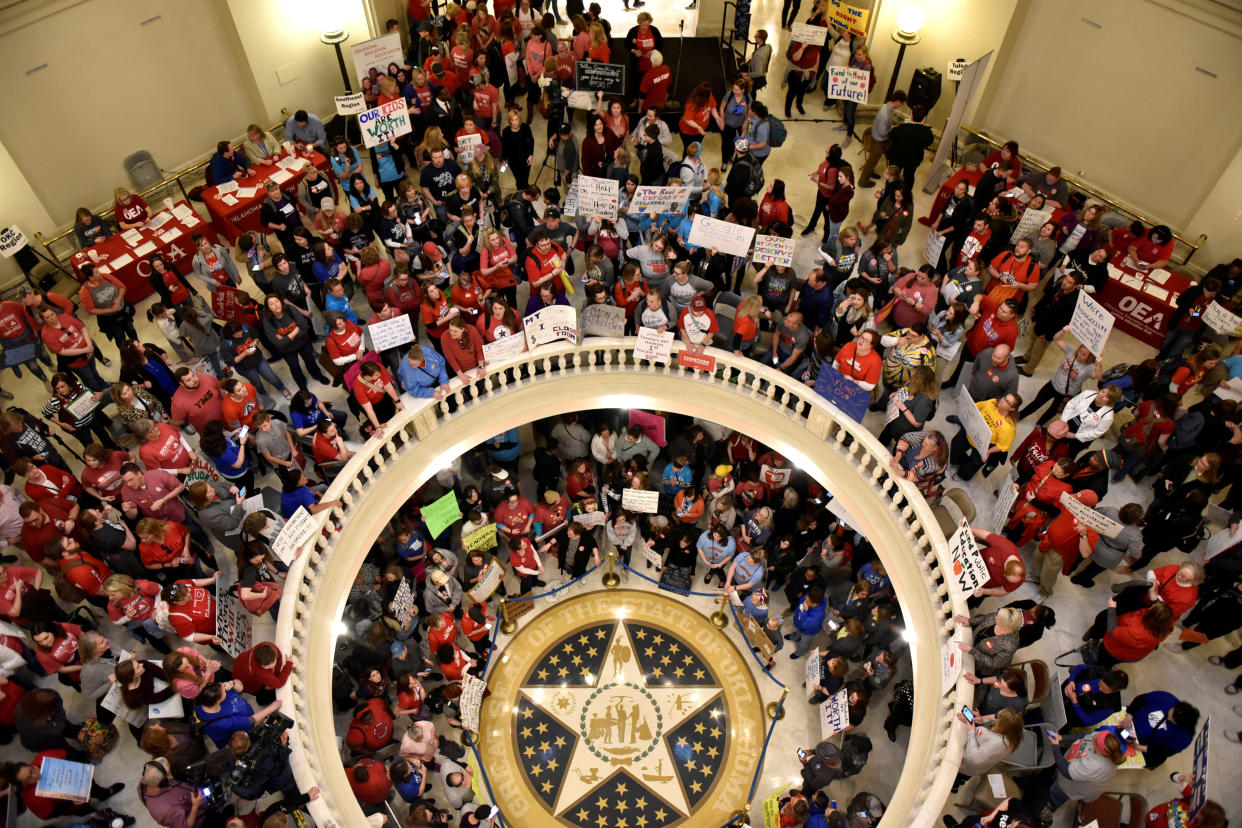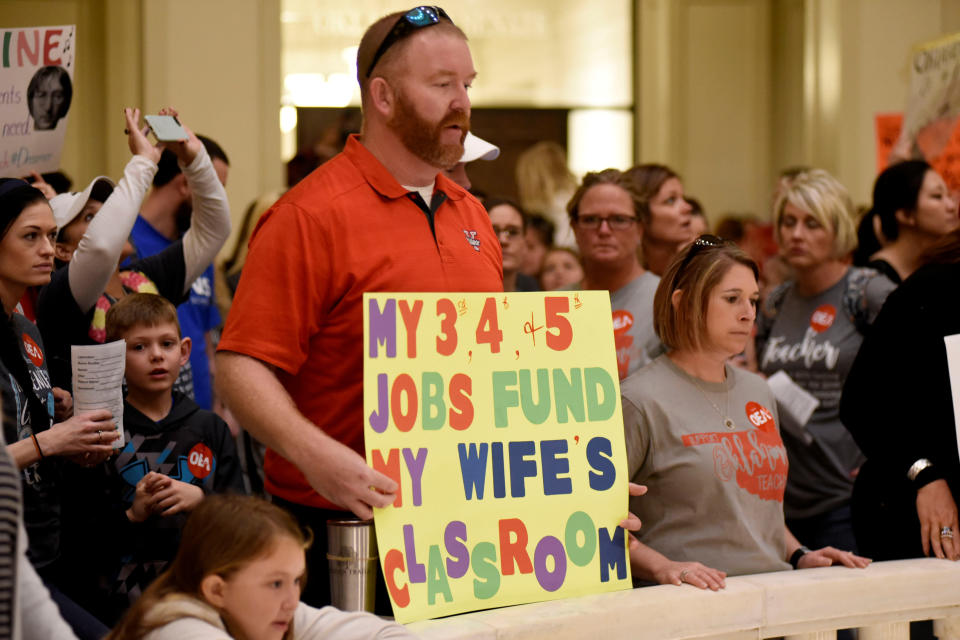Opinion: The Oklahoma Teachers Strike Is 26 Years In The Making

The teachers strike in Oklahoma is 26 years in the making. For two and a half decades, our state’s public education system has been groaning under the growing weight of defunding and disrespect ― and now, the teachers of Oklahoma are at a breaking point.
In 1992, Oklahoma voters passed State Question 640, which requires that any bill to raise revenue must receive a 75 percent supermajority vote in both legislative chambers and be signed by the governor. As a result, any small legislative group that has an issue with a bill or just wants to play political games can shut down meaningful progress. This effectively eliminates the option of raising taxes to fund public education. Since the passage of State Question 640, only one small revenue-raising bill has passed, a 2004 tax on tobacco.
Next, the Oklahoma legislature cut various taxes in hopes of luring companies to the state with the promise of lower taxes (or sometimes no taxes, in the form of long-term tax credits). Their philosophy was that the jobs these businesses would bring into the state would result in more people putting money into the economy through economic activities and taxes. But at the same time, Oklahoma began implementing cuts to personal income taxes, leading to a half-billion dollar cut to the tax base on which public schools depend.
Another major mistake Oklahoma made was to tie a large amount of education funding to the oil and gas industry: A large part of the education budget comes from the Gross Production Tax (GPT) of oil and gas wells. Given the volatility of that industry, this was extremely unwise.
A few years back, when gas was $4.00 a gallon, the oil companies asked that the GPT be lowered from 7 percent to 1 percent so they could invest in drilling research and development. The government obliged. When the oil industry basically tanked and its tax contributions dried up, the 75 percent supermajority rule and the industry’s political influence ensured that the state could not raise the GPT to its previous rate.

All of a sudden, Oklahoma found itself with a 1 billion dollar annual revenue hole. It’s had that hole for five years now. Oklahoma also has one of the lowest property tax rates anywhere, and over the years, much of that money ― which is supposed to go to education ― has been siphoned off to help make up for all of the budget holes. Another growing problem is that the federal government dictates the allocation of the federal dollars we receive, and very little of it goes to education.
There are more causes for the cracks we’re seeing in the state today ― these are just some of the factors that have led us to this dire, and extremely complex, breaking point.
The state’s budget crisis necessitated cuts to many agencies in the state. In the past five years alone, common education in Oklahoma has been cut 28 percent, and the state leads the nation in education cuts. These cuts have been devastating. Teacher salaries in Oklahoma are among the lowest in the nation, and my colleagues and I have not had a raise in 10 years.
Our teachers are able to drive across the border to Texas or Arkansas and make tens of thousands of dollars more. A teacher who is fresh out of college can go to Texas and begin teaching at a higher salary than Oklahoma educators who have been teaching for two decades. Last year’s Oklahoma Teacher of the Year was forced to move to Texas because he couldn’t support his family on his Oklahoma salary. He and his wife ― also a teacher ― immediately made $40,000 more between them. The salary disparity has caused a mass exodus of teachers, and in response, Oklahoma emergency-certified around 5,000 teachers in the last three years alone.
The teacher shortage hits students hard, too. Fewer teachers means larger class sizes; it is not uncommon to see classes of 35 or 40 students or more. To make matters worse, many schools can no longer afford to employ a full support staff, and the result is that teachers have been placed in an impossible situation. They are not teaching under the conditions necessary to provide every child with the quality education they deserve.
And as the money allocated to the general funding formula has dissipated, schools can no longer provide the resources ― like textbooks and technology ― that teachers need to prepare our children for the 21st century world. When you consider that our teachers and schools are evaluated on how their students perform compared to students nationwide who do not face these same obstacles, perhaps you can begin to grasp the frustration and pressure so many of our teachers feel. Now, that frustration has finally boiled over.
Our legislators must finally realize that an education system is the most critical component of a successful society. The teachers who have stayed and fought a courageous battle under extremely difficult circumstances deserve their immediate attention, respect and help in the form of real and tangible resources.
That means paying teachers a living wage. It means providing schools with enough funding to hire qualified teachers to fill every classroom, so that every child has a qualified teacher and every classroom has a manageable number of students. It means funding for textbooks that have all of the pages in them and aren’t held together by duct tape. It means providing the funding necessary to provide updated technology that students need to be able to compete on a level playing field with other students across the country. And it means providing enough funding so that teachers don’t have to spend money out of their own pockets to buy basic classroom supplies.
I have taken issue with the way some educators have responded during this time, but I take no issue with their justified frustration and feelings of hopelessness. As an Oklahoma teacher for 35 years, I get it: I have endured and suffered as much as all of them. I supplement my teaching income with two other jobs ― jobs I enjoy, but jobs nonetheless. My wife, who has been a second-grade teacher for the past 34 years, works two jobs; When she’s not in the classroom, she sells real estate. It’s unacceptable that it takes five jobs between two people to ensure a middle-class existence.
The state of Oklahoma has neglected education for far too long. We can point fingers and blame whomever we wish; as I have already shown, there is plenty of blame to go around. But the time to enact real solutions is right now. Oklahoma has taken a good first step this week in passing a $480 million revenue package to help education, and the legislators who worked tirelessly to make that happen deserve our thanks. But there is much more catching up that needs to be done. It is past time to stop blaming and start fixing.
Jon Hazell has taught anatomy and physiology, biology and an adaptive environmental science class for special needs students at Durant High School for 35 years. He is the current Oklahoma State Teacher of the Year.
Love HuffPost? Become a founding member of HuffPost Plus today.
ALSO ON HUFFPOST OPINION
Striking West Virginia Teachers Remind Us Teaching Is Work
Teachers, Tell Your Students To Walk Out On Wednesday
'Hardening' Our Schools Will Hit Black And Brown Students Hardest
This article originally appeared on HuffPost.
